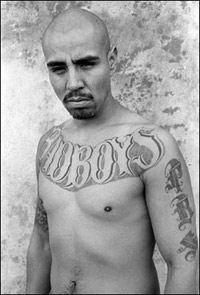 |
 |
 |
 News from Around the Americas | August 2005 News from Around the Americas | August 2005  
Fugitives From Mexico Hide In The Bustle Of Los Angeles
 Matt Krasnowski - Copley News Service Matt Krasnowski - Copley News Service


| | (Photo: Robert Yager) |
Los Angeles – The killers cross the U.S.-Mexico border, assume new identities, get jobs, blend in among Spanish speakers and sometimes enjoy freedom for years.

But these fugitives from the law aren't border-jumpers heading south. As the recent arrest of one of Mexico's most notorious fugitives at a modest home outside Los Angeles showed, some criminals escape justice by heading north.

In the last 10 months, federal immigration officials have helped locate 13 Mexican murder suspects, along with hundreds of other criminals, hiding in plain sight in the Los Angeles area.

Alfredo Ríos Galeana, wanted for bank robberies, kidnappings, murders and an audacious escape from prison nearly 20 years ago, was arrested in mid-July in South Gate, in southeast Los Angeles County.

On Thursday, a Mexican man was arrested in Palmdale, about 40 miles to the north, in connection with a 2003 shooting death that stemmed from a dispute over goats.

While Los Angeles law enforcement officials frequently complain there are hundreds of criminals from California who have escaped justice by fleeing to Mexico, many Mexican criminals know that in the ethnic enclaves of Southern California, they can enjoy at least a stilted life of freedom.

"There are large pockets in the L.A. area where you could live forever without having to speak English," said Jorge Field, who oversees the U.S. Bureau of Immigration and Customs Enforcement's fugitive operations teams in Los Angeles. "As long as you're law-abiding in the United States, as long as you don't have any contact with police, you can fly under the radar for a long time because there is such a vast population in this area."

Such was the case of Alfredo Ríos Galeana, also known as Arturo Montoya.

In Mexico, Ríos took part in a series of bloody bank robberies that rattled Mexico City in the 1970s and 1980s.

He then fled in 1986 when eight armed men showed up at the prison where he was being held and blasted a hole in the penitentiary wall with a hand grenade.

Using the name Montoya, he lived for at least 12 years in South Gate, a largely Latino community southeast of downtown Los Angeles, with his wife and three children. He ran his own cleaning service company that reportedly had a staff of 40 people, including his son.

The pastor at Montoya's church said the fugitive was actively involved with the parish. A mariachi-style singer, he would perform solos during Sunday services, lead Bible studies and engage in door-to-door outreach.

But a confidential informant tipped officials at the state Department of Motor Vehicles about Montoya's past. The agency notified immigration authorities, and Montoya was arrested and flown to San Ysidro, where Mexican law-enforcement officials took him into custody.

"I was shocked," said Melvin Acevedo, pastor of the Ebenezer World Ministries in Huntington Park, who firmly believes Montoya was committed to his religion. "The guy you have been seeing before you for all this amount of time is not that way at all."

On Thursday, immigration and customs agents made another capture when they arrested Miguel García Chávez, a 49-year-old landscaper, at his Palmdale home.

Officials said that in June 2003, García shot and killed Israel Farías Suárez in a rural town in Jalisco state after an argument about a herd of goats allegedly trespassing on his relative's land.

García has immigration court proceedings pending, said the immigration bureau's spokeswoman Virginia Kice. He is a legal, permanent resident of the United States, but has a prior conviction for spousal battery that makes him potentially deportable.

Field said Mexican fugitives aren't exclusively escaping to Southern California, as more immigrant communities sprout up in the South and Midwest. But the Los Angeles area appears to be the most popular hide-out.

"You can get here and just blend in . . . as opposed to Arkansas, where you've got the five guys standing on the corner that everybody knows," he said.

Congress has designated funding to be used solely for the capture of foreign fugitives in this country.

Fugitive operations teams have captured about 1,900 fugitives on immigration issues in the Los Angeles region during this federal fiscal year, which started in October. Roughly 80 percent of those are criminals.

The number of apprehensions is nearly double the amount of the next closest U.S. region, New York City, and more than three times the amount in San Diego, according to federal officials.

Field said fugitive operations regularly receive tips from foreign law enforcement officials, including the Mexican Attorney General's Office, about suspected fugitives. They also receive tips from local agencies, including the DMV tip that led them to Montoya.

In January, the Los Angeles County Board of Supervisors approved a pilot plan allowing the Sheriff's Department to assist federal immigration officials in identifying foreign-born inmates in the county jail for deportation. | 
 | |
 |



